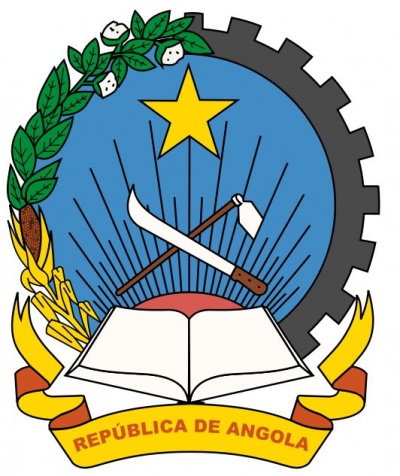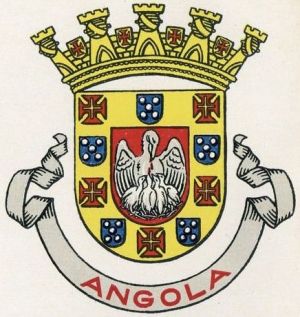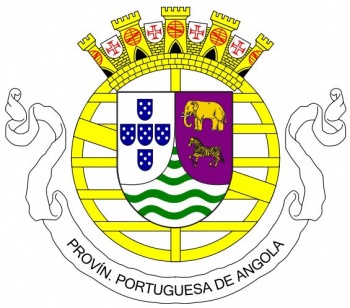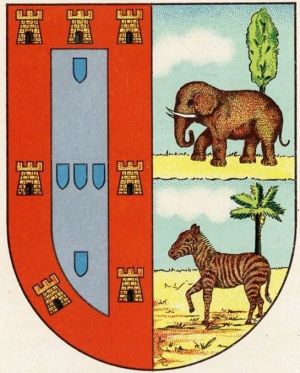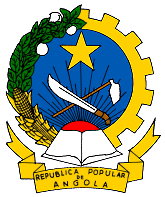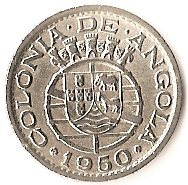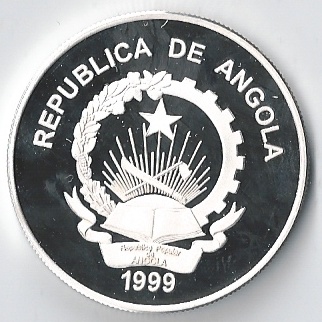National Arms of Angola: Difference between revisions
Knorrepoes (talk | contribs) No edit summary |
Knorrepoes (talk | contribs) m (Text replacement - "===Official blazon===↵↵===Origin/meaning===" to "{| class="wikitable" |+Official blazon |- |'''English''' | blazon wanted |} ===Origin/meaning===") |
||
| (9 intermediate revisions by the same user not shown) | |||
| Line 1: | Line 1: | ||
{ | {{ao}} | ||
'''NATIONAL ARMS OF ANGOLA''' | '''NATIONAL ARMS OF ANGOLA''' | ||
[[File:angola.jpg|center|400 px]] | [[File:angola.jpg|center|400 px]] | ||
====Origin/meaning | {| class="wikitable" | ||
|+Official blazon | |||
|- | |||
|'''English''' | |||
| blazon wanted | |||
|} | |||
===Origin/meaning=== | |||
Angola uses the above State logo, adopted in 1975 and changed in 1992. The difference is the removal of the word 'Popular' in the official name of the country. | Angola uses the above State logo, adopted in 1975 and changed in 1992. The difference is the removal of the word 'Popular' in the official name of the country. | ||
In 1935 the then Portuguese colony received its first arms, based on the same structure as all Portuguese colonies. The upper right half and the bottom are identical for all colonies and show the 5 shields of the Portuguese National arms and the waves for the 'overseas' colonies. The upper left half differs between the colonies and for Angola an elephant and a horse. | ====Colonial arms==== | ||
In June 1932 the first arms for the Portuguese colony of Angola were designed and proposed to the Ministry of Colonies. The arms follow a centralised pattern with a bordure with the castle of Portugal and a cross as used by the Portuguese discoverers. For each province a separate symbol was used as the main charge. For Angola a pelican in her piety was chosen. The reason thereof is not known. These arms were, as far as I know, never officially adopted and replaced in 1935. | |||
{|align="center" | |||
|align="center"|[[File:angola1932.jpg|center|300 px|Colonial arms of Angola]] <br/>The proposal from 1932 | |||
|} | |||
On May 8 1935 the then Portuguese colony received its first arms, again based on the same structure as all for Portuguese colonies. The upper right half and the bottom are identical for all colonies and show the 5 shields of the Portuguese National arms and the waves for the 'overseas' colonies. The upper left half differs between the colonies and for Angola an elephant and a horse. The motto read Portuguese Colony of Angola. | |||
When in 1951 the colony was transformed into a province, the text on the banner was changed. The arms were abandoned at the independence in 1975.<br/> | When in 1951 the colony was transformed into a province, the text on the banner was changed. The arms were abandoned at the independence in 1975.<br/> | ||
{|align="center" | {|align="center" | ||
|align="center"|[[File:angola1.jpg|center|300 px]] <br/>The arms from 1935 | |align="center"|[[File:angola1.jpg|center|300 px|Colonial arms of Angola]] <br/>The arms from 1935 | ||
|align="center"|[[File:angola2.jpg|center|350 px]] <br/>The arms from 1951 | |align="center"|[[File:angola2.jpg|center|350 px|Colonial arms of Angola]] <br/>The arms from 1951 | ||
|- | |- | ||
|align="center"|[[File:angola3.jpg|center]] <br/>The arms from 1975 | |align="center"|[[File:angola5.jpg|center|300 px|Colonial arms of Angola]] <br/>A different version of the colonial arms | ||
|align="center"|[[File:angola3.jpg|center|National arms of Angola]] <br/>The arms from 1975 | |||
|- | |- | ||
|align="center"|[[File:ao-c1.jpg|center]] <br/>Coin with the colonial arms | |align="center"|[[File:ao-c1.jpg|center|Colonial arms of Angola]] <br/>Coin with the colonial arms | ||
|align="center"|[[File:ao-c2.jpg|center]] <br/>Coin with the present arms | |align="center"|[[File:ao-c2.jpg|center|National arms of Angola]] <br/>Coin with the present arms | ||
|} | |} | ||
{{media}} | |||
[[Literature]] : http://www.christian-siemer.de/wappen/afrika/angola | [[Literature]] : http://www.christian-siemer.de/wappen/afrika/angola | ||
Latest revision as of 14:07, 29 January 2024
| Heraldry of the World |
| Angola heraldry portal |
NATIONAL ARMS OF ANGOLA
| English | blazon wanted |
Origin/meaning
Angola uses the above State logo, adopted in 1975 and changed in 1992. The difference is the removal of the word 'Popular' in the official name of the country.
Colonial arms
In June 1932 the first arms for the Portuguese colony of Angola were designed and proposed to the Ministry of Colonies. The arms follow a centralised pattern with a bordure with the castle of Portugal and a cross as used by the Portuguese discoverers. For each province a separate symbol was used as the main charge. For Angola a pelican in her piety was chosen. The reason thereof is not known. These arms were, as far as I know, never officially adopted and replaced in 1935.
| The proposal from 1932 |
On May 8 1935 the then Portuguese colony received its first arms, again based on the same structure as all for Portuguese colonies. The upper right half and the bottom are identical for all colonies and show the 5 shields of the Portuguese National arms and the waves for the 'overseas' colonies. The upper left half differs between the colonies and for Angola an elephant and a horse. The motto read Portuguese Colony of Angola.
When in 1951 the colony was transformed into a province, the text on the banner was changed. The arms were abandoned at the independence in 1975.
| The arms from 1935 |
The arms from 1951 |
| A different version of the colonial arms |
The arms from 1975 |
| Coin with the colonial arms |
Coin with the present arms |
Contact and Support
Partners:
Your logo here ?
Contact us
© since 1995, Heraldry of the World, Ralf Hartemink 
Index of the site
Literature : http://www.christian-siemer.de/wappen/afrika/angola



